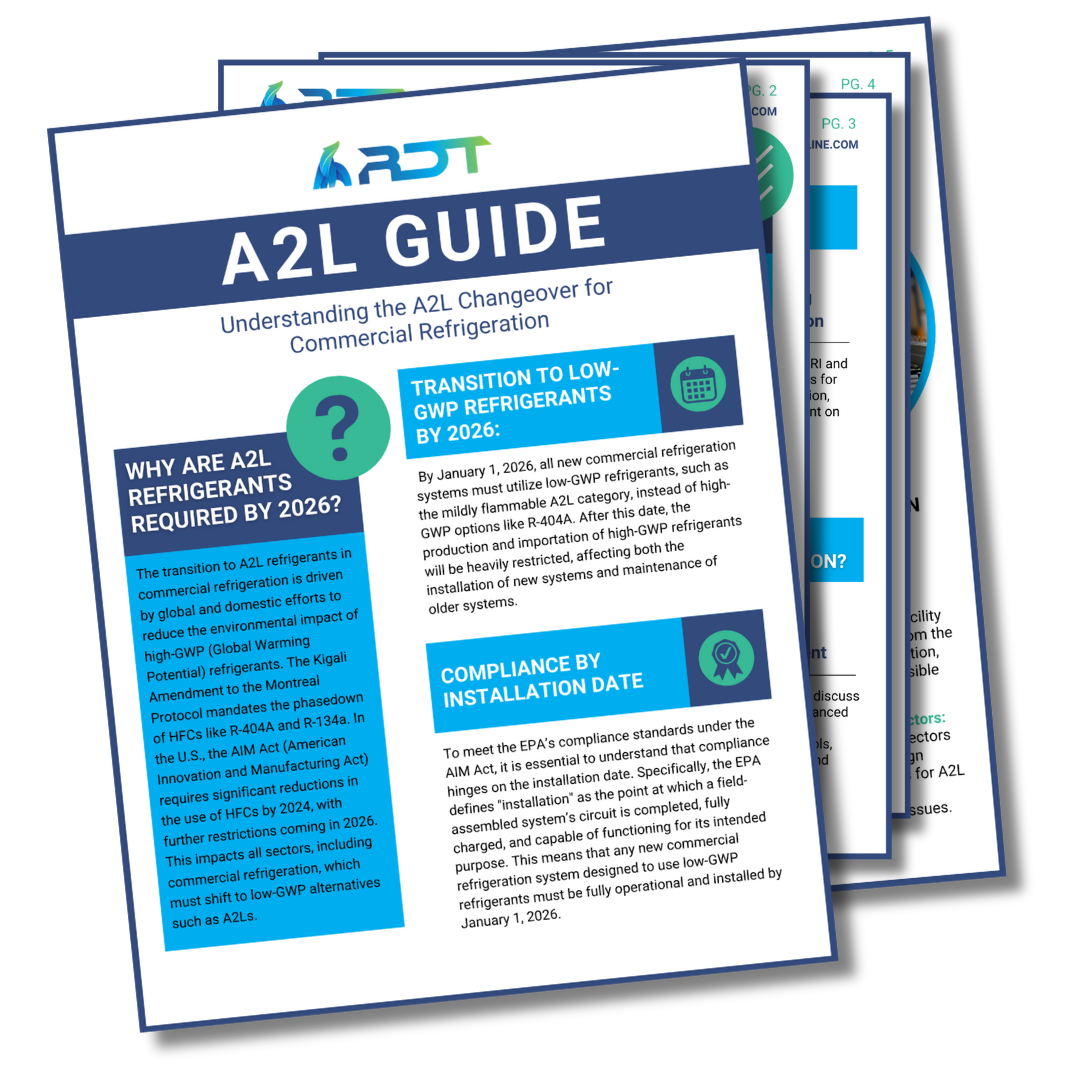Next-Gen Refrigeration
New regulations. New refrigerants. Same RDT support.
A2L Transition: Where Things Stand Now
(Updated 12/05/2025)
The industry is still operating under the January 1, 2026, A2L Transition implementation date while the EPA reviews public comments on its proposed rule. Until a final rule is published, the AIM Act Technology Requirements remain fully in effect.
Key milestones so far:
- Proposed rule published October 3, 2025
- Public hearing held October 20, 2025
- Comment period closed November 21, 2025
What could shift:
Enforcement timing, Global Warming Potential (GWP) limits, or application categories, depending on the final rule.
What won’t change:
The long-term move to lower-GWP refrigerants. A2L systems will continue to shape future refrigeration design.
RDT will keep this A2L Resource Hub updated as new details emerge so operators and partners have a clear and informed path forward.
.
What is the new EPA Proposed Rule on A2L?
Explore our continually updated blog for the latest regulatory insights.
How Are A2L Systems Different from Traditional Refrigeration Systems?
A2L systems are engineered with additional safety, ventilation, and leak detection measures to account for the mild flammability of the refrigerant. These design differences ensure compliance with updated safety standards like UL 60335-2-89 and ASHRAE 15.
Key Differences in A2L Systems
1. Leak Detection Systems
Required in most applications using A2Ls
Monitors for refrigerant leaks in enclosed spaces
Automatically triggers alarms or system shutdown if thresholds are exceeded
2. Ventilation or Airflow Management
May require mechanical ventilation in equipment rooms or confined spaces
Prevents refrigerant concentrations from reaching flammable levels
3. Charge Size Limits
Subject to strict maximum charge amounts based on room size, application, and presence of leak detection
System design must account for these limits to stay compliant
4. Spark-Free Electrical Components
Components in areas where refrigerant may accumulate must be ignition-protected or spark-free
5. Safety Control Logic
Built-in logic shuts down compressors and activates ventilation systems automatically in the event of a leak
What Are A2L Refrigerants? Why Are They Important?
A2L refrigerants are low-GWP (Global Warming Potential), mildly flammable alternatives to older refrigerants like R-404A. They are essential for meeting EPA and AIM Act regulations taking effect January 1, 2026.
💡 Want to understand how this regulation impacts your operation?
[Download our full A2L Transition Guide]
When Is the EPA’s A2L Refrigerant Deadline?
Deadline: January 1, 2026
All new refrigeration systems must use compliant, low-GWP refrigerants like A2Ls by this date. Compliance is based on the installation date, not the purchase date.
📅 Need help planning your timeline?
[Grab the checklist in our free guide]
Can I Retrofit My Existing Refrigeration Systems to Use A2Ls?
In most cases, no. Retrofitting is not allowed due to pressure and flammability differences. A full system replacement is usually required.
🛠 Not sure whether to replace or upgrade?
[Get expert advice in our A2L Transition Guide]
Are There Safety Considerations for A2L Refrigerants?
A2L systems require:
Proper ventilation and airflow controls
Certified leak detection systems
Tools and equipment rated for use with flammable refrigerants
🧯 Explore our safety checklist in the full guide
[See the checklist]
Will Switching to A2L Refrigerants Save Energy or Cost More?
While upfront costs may be higher, A2L systems often deliver 5–10% energy savings compared to legacy HFC systems—providing a long-term return on investment.
⚡ Explore the energy efficiency comparison
[Download the guide]
How Can I Prepare for Supply Chain Delays Ahead of the 2026 Deadline?
Start sourcing compliant equipment early
Build relationships with trusted suppliers
Align early with inspectors and insurance providers
📦 Our guide walks you through every prep step
[Get the planning guide]
What codes or standards apply?
Are there any installation differences compared to A1 refrigerants?
Yes. Most A2L installations will include:
Refrigerant shut-off valves in the suction and liquid lines, installed outside walk-ins
Control via evaporator controller with leak detection sensors
Possible requirements for fire-rated shafts or ventilation systems
Always refer to local building, mechanical, and fire codes along with ASHRAE 15.
Do servicers need special tools to work on A2L equipment?
Yes. Tools must be certified for flammable refrigerants:
Recovery machines, vacuum pumps, hoses, and gauges must be A2L-rated
Spark-proof tools are often required
Open flames or ignition sources must be avoided during service
Will A2L Refrigerants Require New Components?
Yes. A2L-compliant systems require:
Specially designed compressors, condensers, and expansion valves
Electrical components (e.g., contactors, pressure switches, relays, controllers) rated for A2L compatibility

A2L Refrigerant Transition Guide
Don't get left behind in the A2L refrigerant transition. Our comprehensive guide provides essential insights and actionable steps to ensure your compliance and success forthe January 1, 2026 deadline.
WHAT'S IN THE GUIDE?

Future-Proof Plan
Stay ahead of industry trends and position your business for long-term success in the evolving refrigeration landscape.

Regulation Timeline
Clear timeline of EPA regulations and deadlines for A2L adoption.

Bonus: Checklist
Unlock the power of preparedness with our exclusive checklist – your roadmap to A2L compliance success!




